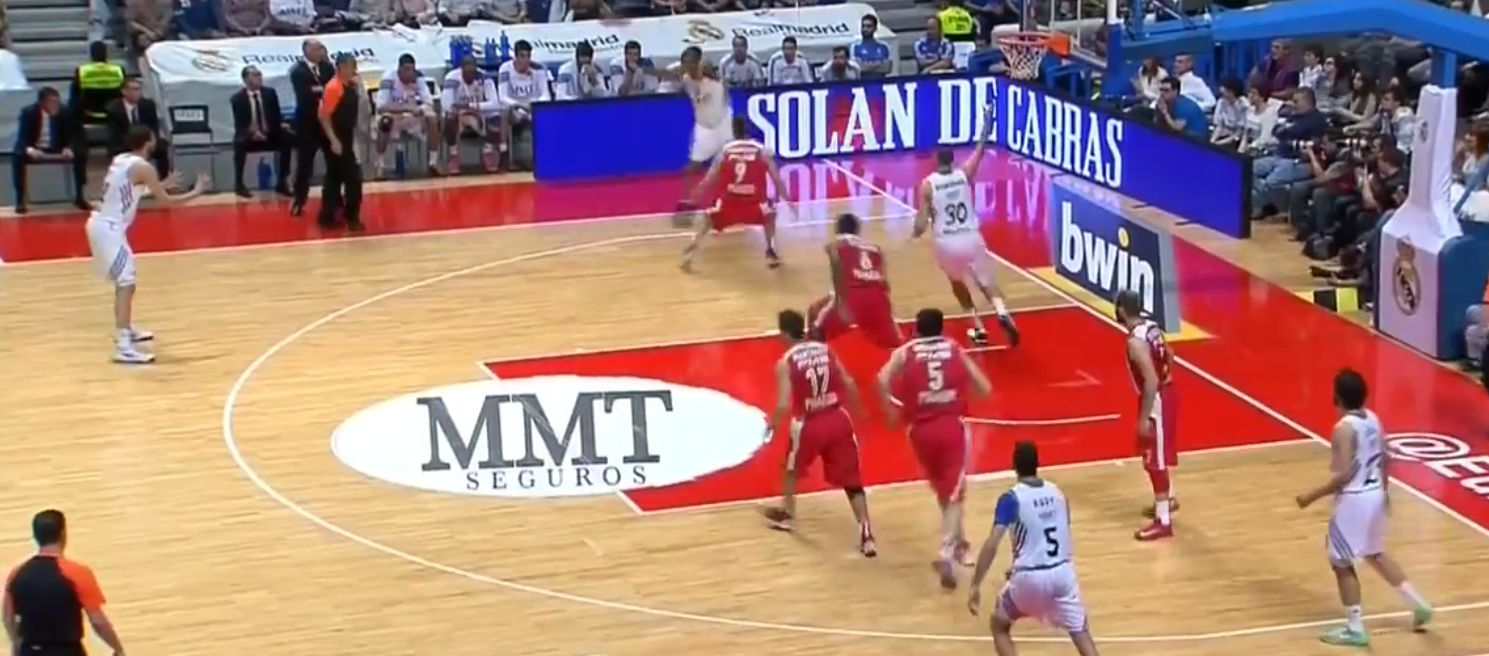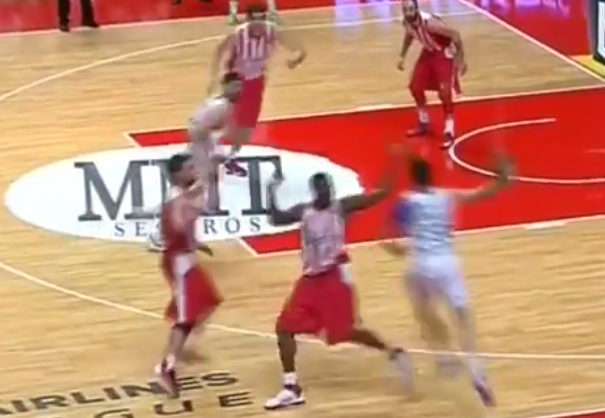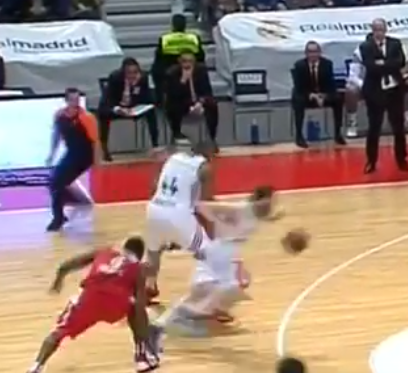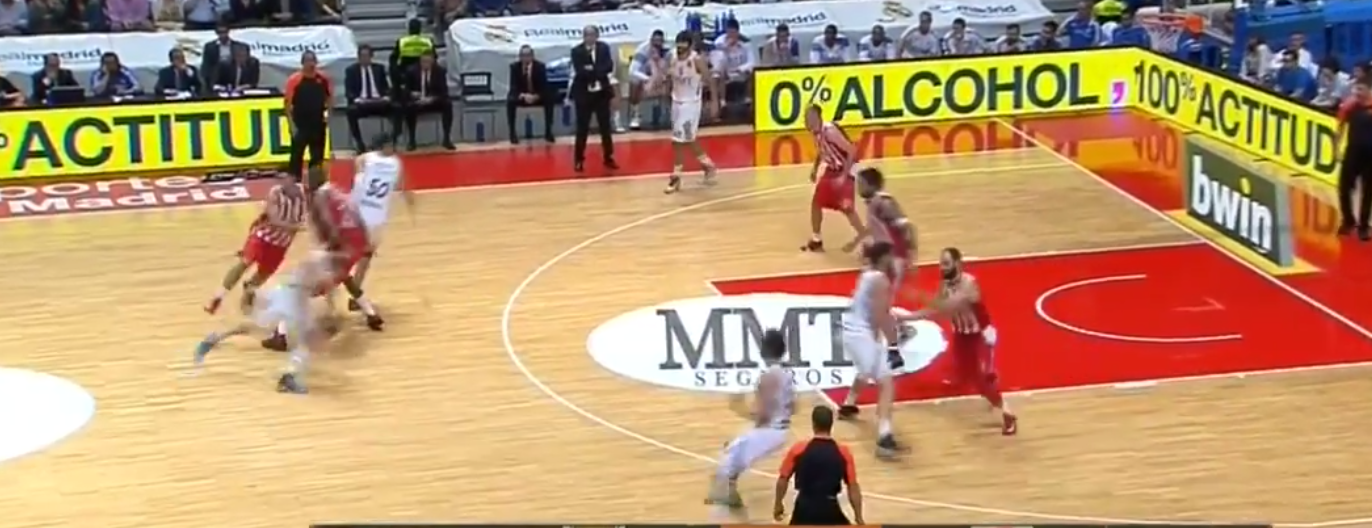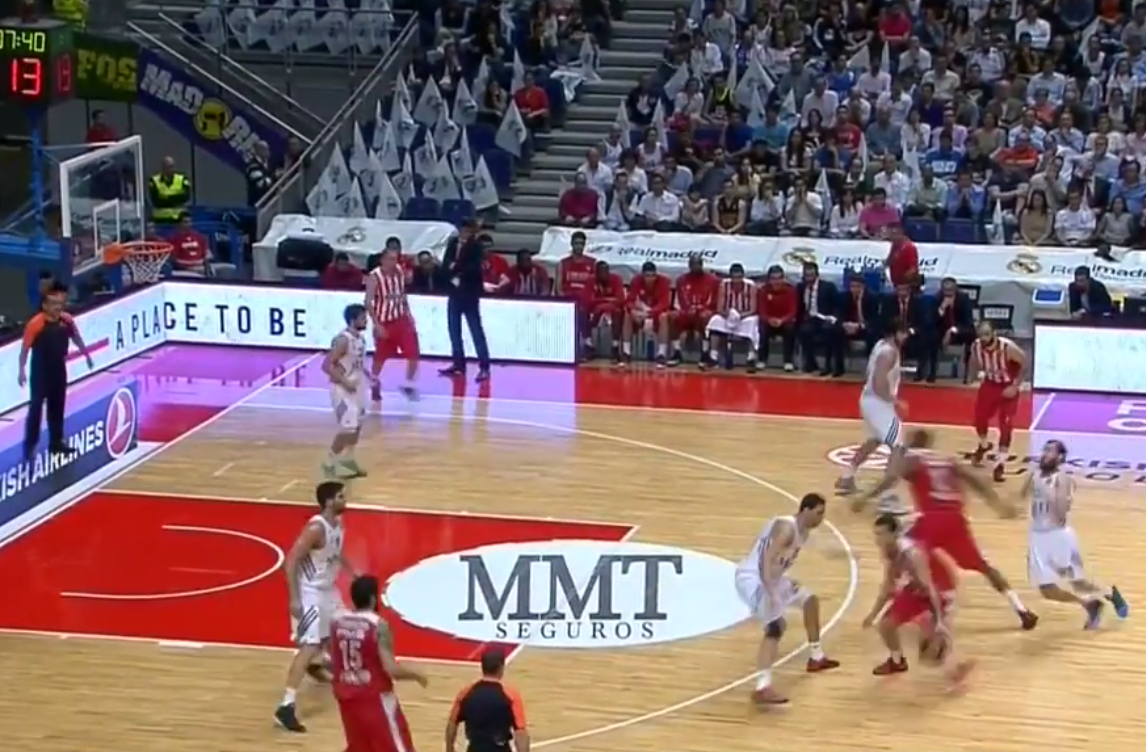In Non-Moving Pictures: A Tale of Two Quarters
It wasn’t competitive for forty minutes, but Game 1 between Real Madrid and Olympiacos was full of storylines: bad blood boiling over on more than one occasions, Rudy playing like an MVP, Mirotic dominating, Spanoulis putting forth a valiant effort and a barrage of three pointers from both teams defining the turning points of the game. However, in terms of Xs & Os, the first half told you almost everything you needed to know about the strengths of Madrid and certain openings that Olympiacos can’t take advantage.
Madrid had done their homework
Coming into the playoffs, Olympiacos lineups featuring Bryant Dunston at power forward were particularly prolific on offense, to the tune of more than 120 points per a hundred possessions. It’s safe to say that this number dropped somewhat after a disastrous start to the game for the champs, who were -12 with that old school formation on the floor. The American center moved to the four during the top 16, as a replacement to the injured Giorgos Printezis. Opponents were often caught off guard, allowing Dunston to dive toward the hoop from the weakside, finishing strong at the rim and pick up a few transition-initiating steals at the perimeter. Pablo Laso had apparently watched enough tape to not fall for this trick.
Vassilis Spanoulis scored zero points and had zero assists at the painted area in the first half. Even though he was perceived (by some unreliable analysts, at least) to have an advantage over Giannis Bouroussis, Olympiacos scored just six points in seven pick and roll plays that had the Reds captain going up against the Greek center. The pictures below explain this number: With Brent Petway picking up two early fouls, spreading the floor was an impossible task. This was especially true when Dunston was the second big man, as Nicola Mirotic was free to roam toward Spanoulis:
Even though there was no room inside, with the aggressive Madrid defense on the ball creating havoc, Bartzokas should not completely ditch this lineup. After all Printezis is coming off a very serious injury and his conditioning is a mystery. Petway is foul prone. However, Dunston seems to match up better against Reyes, whether he is banging for position inside or taking advantage of the Spaniard’s limited mobility at defense (at least compared to the seemingly omnispresent Mirotic). Reyes got in Petway’s head, who seemed overmatched at the post, but can keep up with Mirotic outside, while also keeping weakside defenders honest.
Olympiacos picked more than one poison
Madrid on the other hand, had no spacing issues. They hit their threes and despite an off night by Sergio Rodriguez scored enough points inside off the pick and roll. With Olympiacos turning the ball over at an alarming rate, a popular talking point has been pace and how Madrid controlled it. This was true in the first quarter, when the merengues scored six points on four transition plays. However, they were as effective in a half court setting as the 67-possession pace required them to be. The Reds tried to deal with Madrid pick and rolls by having their big men hedge out. The good news was that S-Rod turned it over twice in the second quarter when faced with this strategy. The bad news was that soft spots kept popping up, inside and out. The best offense in Europe had no problem taking advantage:
With Shermadini stepping outside and Bouroussis rolling to the basket, the Olympiacos power forward has to rotate inside. Mirotic is wide open and proceeds to showcase the full repertoire – pump fake and cross-court hockey assist to Llull who swings it to Rudy. Open three. Madrid also capitalized on the 1-4 pick and roll, as Mirotic and Reyes combined for six points on four plays. In one of those plays, Rudy’s underrated passing ability (underrated even by Rudy himself sometimes) was on display:
Very few point guards in Europe could connect with the roll man from that angle. However, this picture also capture a hole in Olympiacos’ hedge out defense: Dunston often allows the ball handler to turn the corner. One counter would be a deeper rotation by Shermadini, risking a three by Bouroussis or Mejri. But even that option is not available when the ball handler splits the hedge out:
Dunston has been a dominant shot blocker, but his footwork is often questionable. Therefore he often relies on the work done by perimeter defenders on the ground in order to make the most of his ability above the rim. Against Madrid’s explosiveness, he simply has to do more, or risk giving up more three point plays like this one, materialized by Rodriguez at the rim. The same goes for all Olympiacos centers, even when Madrid deploy their non-stretch four lineups:
In theory, Reyes’ limited shooting range would allow a more aggressive approach, as help defenders would have to cover less ground. This is why Printezis is stationed under the basket. However, the hedging defender has to force the ball handler away from the hoop, otherwise Olympiacos guards will not have enough time to recover. This is exactly what happens here, as Rodriguez turns the corner, putting Printezis in an one-against-two situation, which ends up in a Reyes layup.
A couple of potential openings
Simply put, Madrid’s run in the first half was based on a diverse offensive portfolio and a keen awareness of Olympiacos’ spacing issues. The Reds countered with a stretch of hot shooting. Looking ahead to Game 2, Madrid’s success seems more sustainable. However, Olympiacos could resort to certain actions that caused their opponents’ aggressiveness on the ball or against Spanoulis to backfire:
It’s a safe bet that Laso will try to help Spanoulis’ man as much as possible when he’s fighting through picks off the ball. That’s what Rudy does here, opening up a driving lane which results in a Papapetrou layup. Matt Lojeski should also look for such openings, as Olympiacos needs more points from him. There are also some opportunities created by Madrid’s pick and roll defense:
No matter how crowded the paint gets, Olympiacos power forwards should find plenty of room beyond the arc. This is the case with Printezis on this play. There are two ways to take advantage of this space. If the defenders stay inside, Printezis – and Petway – have to shoot. If their man closes out on them, then they have to look for the roll man. Both Bouroussis and Mejri should have some trouble recovering in time. If the ball handler makes a quick pass to the strong side, then there is a possibility for more possessions like this, which concluded with a Printezis-Simmons alley oop.
A major question is whether Olympiacos are actually fit enough to take advantage of the few opportunities created by Madrid’s defense. Spanoulis got to the rim on a couple of plays, but couldn’t finish like he usually does. Has he made a full recovery from his recent knee injury? Printezis performed like the prolific scorer that he is, but he ran out of breath rather quickly, in his first game back from a rib/lower back/Olympiacos-medical-staff-can’t-really-say injury. Perperoglou is sick and likely to sit out game two. Madrid would be a handful even if the champs were in top form. Setting aside Xs and Os then, the question is how deep they can dig to make this series competitive.



